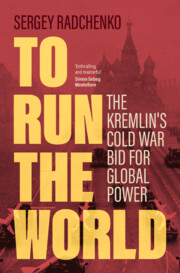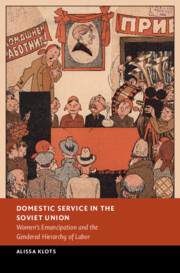189 results
6 - Trouble in the Horn and Soviet Encroachment
- from Part II - Forming an Africa Policy (1971–1975)
-
- Book:
- Pahlavi Iran's Relations with Africa
- Print publication:
- 27 June 2024, pp 150-174
-
- Chapter
- Export citation

To Run the World
- The Kremlin's Cold War Bid for Global Power
-
- Published online:
- 30 May 2024
- Print publication:
- 30 May 2024
1 - A History of Russian–Ukrainian Relations
-
- Book:
- Propaganda and Ideology in the Russian–Ukrainian War
- Published online:
- 16 May 2024
- Print publication:
- 23 May 2024, pp 7-26
-
- Chapter
- Export citation
15 - Australian Relations with the Former Communist States of Europe and the Soviet Union
-
-
- Book:
- Australia in World Affairs 1991–1995
- Published online:
- 04 May 2024, pp 181-192
-
- Chapter
- Export citation
1 - Australia’s ‘Engagement with Asia’
-
-
- Book:
- Australia in World Affairs 1991–1995
- Published online:
- 04 May 2024, pp 1-11
-
- Chapter
- Export citation
2 - An Overview
-
-
- Book:
- Australia in World Affairs 1991–1995
- Published online:
- 04 May 2024, pp 12-22
-
- Chapter
- Export citation

Domestic Service in the Soviet Union
- Women's Emancipation and the Gendered Hierarchy of Labor
-
- Published online:
- 25 April 2024
- Print publication:
- 02 May 2024
Post-Soviet power hierarchies in the making: Postcolonialism in Tajikistan’s relations with Russia
-
- Journal:
- Review of International Studies , First View
- Published online by Cambridge University Press:
- 22 April 2024, pp. 1-21
-
- Article
-
- You have access
- Open access
- HTML
- Export citation
12 - Australia and the Eastern Bloc
- from Part 2 - Australia and the Regions
-
-
- Book:
- Australia in World Affairs 1981–1990
- Published online:
- 29 March 2024, pp 225-245
-
- Chapter
- Export citation
14 - Former Soviet States of Eastern Europe, Caucasus and Central Asia
- from Part II - Legal Families and Geographical Comparisons
-
-
- Book:
- The Cambridge Handbook of Comparative Law
- Published online:
- 26 January 2024
- Print publication:
- 01 February 2024, pp 275-301
-
- Chapter
- Export citation
7 - Easter Offensive and Linebacker I & II: 1972–1973
-
- Book:
- Tactical Air Power and the Vietnam War
- Published online:
- 04 January 2024
- Print publication:
- 18 January 2024, pp 163-201
-
- Chapter
- Export citation
“And I Believe in Signs”: Soviet Secularity and Islamic Tradition in Kyrgyzstan
-
- Journal:
- Comparative Studies in Society and History / Volume 66 / Issue 2 / April 2024
- Published online by Cambridge University Press:
- 11 January 2024, pp. 342-368
-
- Article
-
- You have access
- Open access
- HTML
- Export citation
Chapter 3 - Occasions
-
- Book:
- Persianate Verse and the Poetics of Eastern Internationalism
- Published online:
- 14 December 2023
- Print publication:
- 21 December 2023, pp 105-130
-
- Chapter
- Export citation
Chinese Observations of Soviet Nationality Affairs in the Mao and post-Mao Eras
-
- Journal:
- Nationalities Papers , FirstView
- Published online by Cambridge University Press:
- 15 December 2023, pp. 1-19
-
- Article
- Export citation
8 - The Russian and Soviet Empire
- from Part I - Imperial and Postcolonial Settings
-
-
- Book:
- The Cambridge History of Nationhood and Nationalism
- Published online:
- 08 November 2023
- Print publication:
- 09 November 2023, pp 158-178
-
- Chapter
- Export citation
10 - World War II Reparations to the Soviet Bloc
-
- Book:
- When Nations Can't Default
- Published online:
- 19 October 2023
- Print publication:
- 02 November 2023, pp 133-138
-
- Chapter
- Export citation
4 - The Return and End of the Cold War
- from Part I - Values and Policies in American Foreign Affairs
-
- Book:
- American Foreign Policy and Process
- Published online:
- 19 October 2023
- Print publication:
- 02 November 2023, pp 123-167
-
- Chapter
- Export citation
Worldmaking in the Hijaz: Muslims between South Asian and Soviet Visions of Managing Difference, 1919–1926
-
- Journal:
- Comparative Studies in Society and History / Volume 66 / Issue 1 / January 2024
- Published online by Cambridge University Press:
- 25 October 2023, pp. 185-212
-
- Article
-
- You have access
- Open access
- HTML
- Export citation
Hezb-e Tudeh-ye Iran and Its Struggle Against the Challenges Posed Against It by the British, 1942–1946: An Analysis Based on Soviet Documents
-
- Journal:
- Iranian Studies / Volume 57 / Issue 1 / January 2024
- Published online by Cambridge University Press:
- 10 October 2023, pp. 165-179
- Print publication:
- January 2024
-
- Article
-
- You have access
- Open access
- HTML
- Export citation
3 - Austria
-
- Book:
- The Soviet Union and the Construction of the Global Market
- Published online:
- 31 August 2023
- Print publication:
- 14 September 2023, pp 100-127
-
- Chapter
- Export citation



